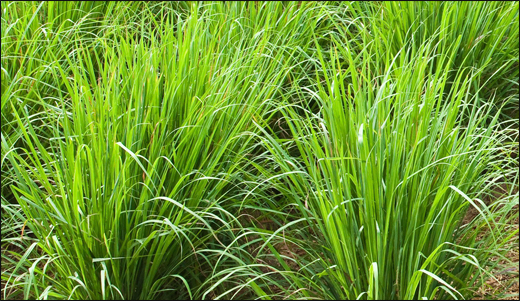Rosha Grass/ Cymbopogon martini – Ayurvedic Properties, Benefits, Uses & More
Abstract
Cymbopogon martini, commonly known as Palmarosa, is a fragrant grass renowned for its therapeutic and aromatic benefits. It is widely used in traditional systems of medicine, especially Ayurveda, and it holds significance for its antibacterial, antifungal, and rejuvenating properties. The extracted essential oil from its leaves and flowering tops plays a vital role in perfumery and aromatherapy. Its natural constituents have a broad spectrum of medicinal uses, including skincare, digestive support, and fever management. It is adaptable to various environments, thriving in tropical and subtropical climates. Palmarosa offers a botanical synergy between wellness and nature, making it valuable in modern and traditional healing practices.

Introduction
Cymbopogon martini is a highly aromatic grass cultivated extensively for its essential oil, which is widely utilized in the pharmaceutical and fragrance industries due to its therapeutic properties. The oil contains a range of biologically active compounds known for their antimicrobial, antifungal, antiviral, anthelmintic, antioxidant, and chemopreventive effects. These medicinal attributes make it a valuable ingredient in natural health formulations and aromatic therapies. In addition to its cultivated presence, Cymbopogon martinii also grows abundantly in the wild, particularly in the Devarayana Durga hills of Tumkur district, Karnataka, India. This region provides favorable climatic and soil conditions that support its natural proliferation. The plant’s ecological adaptability and commercial importance have led to increased interest in its cultivation and study.
Scientific Classification
- Kingdom : Plantae
- Division : Magnoliophyta
- Class : Liliopsida
- Order : Poales
- Family : Gramineae (Yava kula)
- Genus : Cymbopogon
- Species : Cymbopogon martini
Synonyms
- Dhoopa Gandhika – Grass with a pleasant fragrance
- Sougandhika – Pleasant-smelling grass
- Kattrina
- Devajagdha
- Shabala
- Puti
- Bhutika
- Dhyamaka
- Mudgala
- Paura
- Shyamaka
- Davadagdha
- Devadagdha
- Binduchira
- Baram
- Bhutida
- Devadandaka
- Devajagdha
- Vyamapaura
Vernacular Names
- Hindi : Rusa Ghas, Rosha Ghas
- English : Rusa Grass, Palmarosa Grass, Rosha Grass
- Bengali : Aghiyaga Ghas
- Gujarati : Romsado
- Marathi : Rohish
- Tamil : Kavathampillu
- Telugu : Rohisha
- Malayalam : Rohisha
- Kannada : Rohisha Gida
Habitat
Cymbopogon martini is native to India and other tropical regions of South Asia. It thrives in well-drained loamy soils under full sunlight. The plant prefers humid climates and is commonly found in grasslands, open forests, and cultivated fields. It is now grown commercially in several countries for its essential oil, especially in Africa and Central America.
Morphology
Rohisha (Cymbopogon martinii) is a small, perennial aromatic herb that typically grows to a height of 2–3 meters. It is commonly found across temperate regions of India. The plant has smooth, pale white stems from which long, narrow leaves emerge. These leaves are aromatic, measuring about 7–8 inches in length and approximately 1 inch in width, tapering to a pointed tip. The flowers remain partially concealed within the foliage and generally bloom during the winter season.
Varieties
There are two main varieties of Cymbopogon martini:
- Motiya : Known for producing superior quality essential oil.
- Sofia : Preferred for its higher yield of oil.
Classical Categorisation
- According to Charaka Samhita : Sthanyajanana (lactation-inducing) group
- According to Bhavaprakasha Nighantu : Guduchyadi Varga
- According to Dhanvantari Nighantu : Guduchyadi Varga
- According to Kaiyadeva Nighantu : Aushadhi Varga
- According to Raj Nighantu : Shalmalyadi Varga
Ancient Verses
रौहिषं तुवरं तिक्तं कटुपाकं व्यपोहति । हत्कण्ठव्याधिपित्तास्त्रशूलकासकफज्वरान् ॥
(Bhavprakash Nighantu Guduchyadi varga 168)
According to the above shloka, Rosha grass has a bitter and pungent taste, and the post-digestion effect is also pungent. It is effective in the management of heart, throat, bleeding disorders, pain, cough and fever due to Kapha dosha.
Ayurvedic Properties
- Taste (Rasa) : Bitter (Tikta), Pungent (Katu)
- Physical property (Guna): Light (Laghu), Sharp (Teekshna), Dry (Rooksha)
- Potency (Veerya) : Hot Potency (Usna)
- Post-digestion effect (Vipaka) : Katu (Pungent)
- Effect on tridosha : Balance Vata and Kapha dosha
Therapeutic Properties
- Raktapitta : Bleeding disorders such as nasal bleeding, heavy periods
- Kandu : Itching, pruritus
- Hrudroga : Cardiac disorders
- Krumi : Worm infestation
- Kasa : Cough, cold
- Jvara : Fever
- Shwasa : Asthma and chronic respiratory disorders
- Shoola : Abdominal colic pain
- Ajeerna : Indigestion
- Aruchi : Anorexia
- Kantha Vyadhi : Throat disorders, hoarseness of voice
- Balagraha : Psychiatric disorders in children
Systemic Actions
External Application
It possesses pain-relieving properties, and its paste application is beneficial in skin ailments, rheumatoid arthritis, alopecia and related conditions.
Internal Uses
- Digestive System : Enhances taste perception, acts as a carminative, supports balanced dosha movement and has anti-parasitic effects. Useful in anorexia, poor appetite, indigestion, dysentery, diarrhoea, worm infestations and abdominal cramps.
- Circulatory System : Acts as a cardiac stimulant and purifies the blood. Recommended in conditions like rheumatoid arthritis.
- Respiratory System : Helps eliminate aggravated kapha and is Effective in managing cough, asthma, and allergic rhinitis.
- Reproductive System : Supports lactation and promotes milk secretion in nursing mothers.
- Excretory System : Promotes diuresis and is Helpful in relieving painful urination (dysuria).
- Tapakrama : Reduces fever and exhibits antipyretic action.
- Tvak (Skin) : Stimulates perspiration. Indicated in various skin-related disorders.
Chemical Composition
- The Motia variety produces essential oil rich in Geraniol (80–90%), commonly known as Palmarosa oil.
- The Sofia variety yields oil with lesser Geraniol content, referred to as Ginger grass oil.
Other key constituents found in the plant:
- Linalol
- Geranyl acetate
- Geranyl formate
- Carvone
Practical Uses
- A decoction of Rohisha is administered in a dose of 50–60 ml to manage intestinal worms and diarrhoea.
- The paste of leaf and stem is applied externally on areas affected by scabies and skin discolouration.
- The oil extract mixed with hot water is used for steam inhalation in asthma and the common cold.
- The plant is boiled in cow milk and given as a drink (40–50 ml) to enhance breast milk in nursing women.
- A decoction of Rohisha (50–60 ml) is used as a blood purifier and to strengthen cardiac muscles.
- The plant paste is applied to painful, inflamed joints to help relieve swelling and discomfort.
- A cold infusion of the plant is given in a 50 ml dose for treating fever and loss of appetite.
Special Note
There is a lot of difference of opinion in the botanical sources of aromatic grasses. Some have associated their synonyms with one, while others have associated them with the other. The synonym ‘Shyamak’ written in the original may possibly be Dhyamak. Some scholars consider Katrun to be Cymbopogon citratus. Acharya Sharmaji has considered Katrun to be Cymbopogon jwarancusa and Dhyamak to be Valeriana pyrolaefolia, which is similar to Maansi because Dhyamak is mentioned along with other aromatic substances such as Maansi, Tagar and Kushth. Bhavamishra considers Rohish to be Katrun, and today it is available by the name Rusa. It is possible that the name Rusa (Rohish) has come from more than one plant. Motiya is found to be a type of Rusa, the same would be Katrun or Dhyamak, and (Cymbopogon schoenanthus) would be its representative.
Part Used
- Stem
- Leaves
- Flowers
Dosage
- Decoction : 50-80 ml
- Essential oils : 1-3 drops
Conclusion
Cymbopogon martini, or Palmarosa, is a valuable medicinal herb offering a multitude of therapeutic and aromatic benefits. Its essential oil serves as a natural remedy for various skin, digestive and neurological issues. With a rich history in traditional medicine and growing popularity in aromatherapy, it bridges the gap between ancient healing and modern wellness. Sustainable cultivation and proper usage of this fragrant grass can enhance holistic health and promote natural living.



